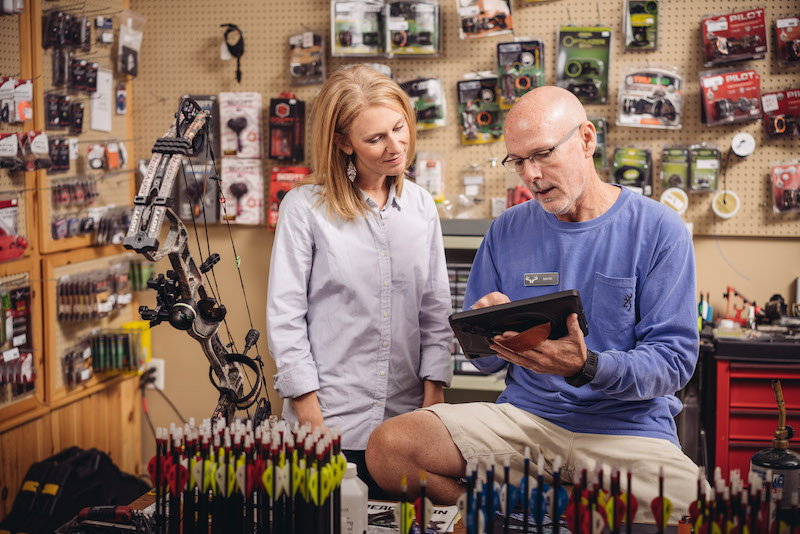BusinessMarketing
Technology Boosts Business by Connecting You to Customers
By integrating automated technologies into your business you’ll boost your profits and customer satisfaction.
Photo Credit: ATA
What if you could show customers what they need before they need it? Modern technologies can make that wild concept your reality. Let’s discuss how technology can boost your shop’s profits and improve customer satisfaction.
To learn what your customers want before they do, you must know them. Fortunately, you have the necessary expertise and experience to do so. You’re an archery pro. You know the equipment and, more importantly, its many levels. That knowledge helps you predict which items your archers will need to upgrade or customize their setups.
You can also identify which customers are beginning, intermediate or advanced archers. That helps you suggest appropriate classes or lessons for their skillset. You can also suggest they try an archery discipline– such as bowhunting or bowfishing, or 3D or competitive archery – based on their skills and interests. Next-step opportunities keep them engaged in archery and your business.
Your keen observations are great, but they have potential hurdles: your memory. It’s almost impossible to remember every customer’s interests, skillsets and setups. That’s where technology shines.

Have customers create a profile so you can keep track of their purchases. Photo Credit: Celerant
If you rely on your memory – or even pen and paper or Excel spreadsheets – to retain customer information, consider easing your burden. Electronic point-of-sale systems do many things, such as collecting and storing your customers’ contact information, purchasing histories, brand preferences, lessons and league histories, and other individual details.
By studying that information to better understand their interests and advancements, you can anticipate their needs and customize your promotions to reach them.
Not all point-of-sale systems are created equal, of course. Make sure yours offers all the features you need, including an automated email system that helps you work efficiently. Automated processes save time, money and effort.

If you have their email, you can send them notices about events or products you think they might be interested in. Photo Credit: ATA
Once you’re tracking and organizing customer data, you’ll know your customers’ skills and gear preferences. Use that technology to show them what they need with automated emails!
These systems help you set up “journeys” or “workflows” that send emails to individual customers after they take specific actions. When someone buys a bow, your system should be programmed to email them information or promotions on possible products to upgrade, including sights, stabilizers, arrow rests and wrist straps.
Likewise, when archers spend a day on your range, your system can automatically email them about upcoming classes or range events. Targeted emails deliver personal, intuitive service based on customers’ purchases and preferences. And because the promotion or suggested products match their needs, the email urges a click that converts into sales. You’ll also boost customer satisfaction by suggesting items that complete or complement their setups.
With automated emails, you create and program an email once, and then it automatically delivers itself based on “triggers” you create from customers’ activities and buying decisions. A trigger is a specific customer action that alerts the system to send your email. Meanwhile, you stay focused on more important tasks.
By automating parts of your communication strategy, you stay proactive, not reactive. In other words, you’re showing your customer what they need before they know they need it.
To further increase your efficiency, divide your customers into segments to ease your communication efforts. Those segments are based on criteria such as their interests, locations, buying histories and archery disciplines. By grouping your customers based on shared traits, you deliver more relevant information and strengthen relationships.
Your customers can also “self-segment” when signing up for your emails. Create several email subjects or categories such as sales, events, new products and special promotions, and let them pick what they want to receive.
Then, go a step further and include their name in your emails. Most email systems let users add “personalization tags” based on customer data you collect. Email systems work differently, but you can usually include a tag that changes to display information relevant to each recipient.

WE ARE HERE TO HELP THE INDUSTRY, TO HELP INDIVIDUAL BUSINESSES GET THE MOST OUT OF THE INDUSTRY, AND TO HELP YOU.

Use the customer's first name to personalize emails. Photo Credit: Campaign Monitor
For example, an email provider called Campaign Monitor lets businesses create a first-name tag, which you set up in your email introduction by saying, “Hello [first name].” The email then converts “[first name]” to the customer’s name in your system’s data base.
People like seeing their name, and personalized emails help you engage with your subscribed customers and improve your email’s marketing performance. You likely address in-shop customers by name, right? Well, email etiquette is no different. Your platform’s personalization rules can teach you how to set up name tags.
To further improve your technology game, read the “Help” section for your email or point-of-sale system.
If these strategies sound confusing or overly complicated, don’t worry. The ATA’s MyATA service providers can help. These ATA-vetted companies offer discounts and expert support to ATA members. Select MyATA service providers offer affordable point-of-sale systems and marketing plans. To view your options, log into your MyATA member dashboard and click “MyATA Service Providers.”
If you have questions or want more information, please contact Kurt Smith, ATA’s director of industry relations, at kurtsmith@archerytrade.org.
